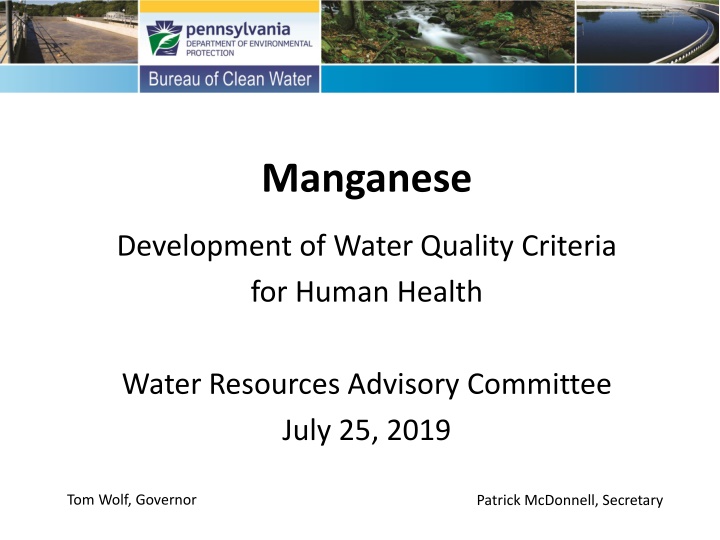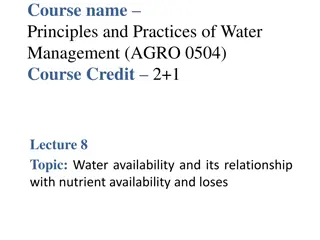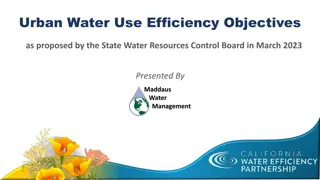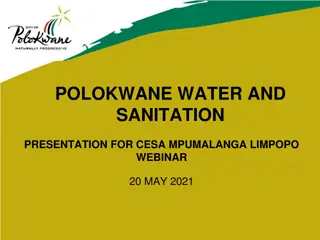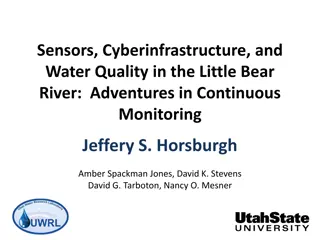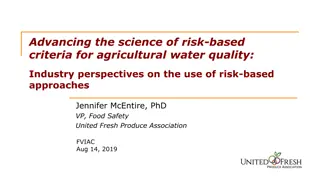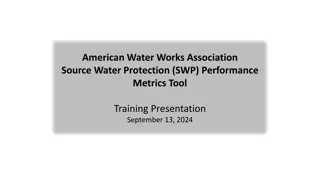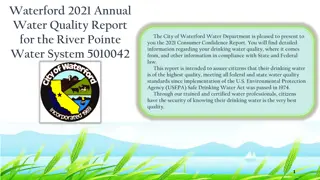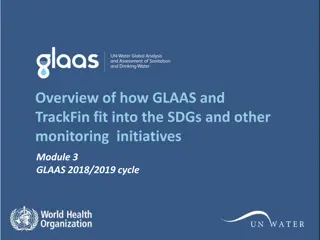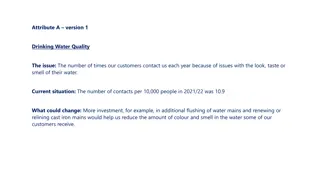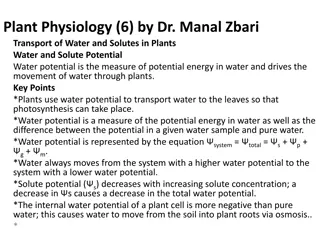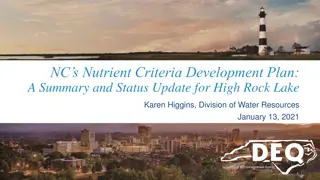Development of Water Quality Criteria for Human Health Protection
The development of water quality criteria for human health protection, particularly focusing on manganese, is crucial for ensuring safe drinking water. This process involves setting guidelines and standards to address potential risks associated with manganese exposure in water sources. Public drinking water suppliers face challenges in removing manganese efficiently, necessitating modifications in treatment processes. The proposed rule includes a toxic substance criterion for manganese, emphasizing the importance of safeguarding human health from potential toxic effects.
Download Presentation

Please find below an Image/Link to download the presentation.
The content on the website is provided AS IS for your information and personal use only. It may not be sold, licensed, or shared on other websites without obtaining consent from the author.If you encounter any issues during the download, it is possible that the publisher has removed the file from their server.
You are allowed to download the files provided on this website for personal or commercial use, subject to the condition that they are used lawfully. All files are the property of their respective owners.
The content on the website is provided AS IS for your information and personal use only. It may not be sold, licensed, or shared on other websites without obtaining consent from the author.
E N D
Presentation Transcript
Manganese Development of Water Quality Criteria for Human Health Water Resources Advisory Committee July 25, 2019 Tom Wolf, Governor Patrick McDonnell, Secretary
Manganese : Criteria Development Act 40 October 30, 2017 Advanced Notice of Proposed Rulemaking January 27, 2018 Science Presentation to WRAC May 23, 2019 2
Manganese : Criteria Development CHAPTER 93. WATER QUALITY STANDARDS * * * * * * WATER QUALITY CRITERIA * * * * * * TABLE 3 Parameter Symbol Criteria Critical Use* * * * * * * Iron 30-day average 1.5 mg/l as total recoverable. CWF, WWF, TSF, MF PWS PWS PWS Fe1 Maximum 0.3 mg/l as dissolved. Maximum 1.0 mg/l, as total recoverable. Maximum 10 mg/l as nitrogen. Fe2 Mn N Manganese Nitrite plus Nitrate * * * * * * CHAPTER 96. WATER QUALITY STANDARDS IMPLEMENTATION * * * * * * 96.3. Water quality protection requirements. * * * * * * (d) As an exception to subsection (c), the water quality criteria for total dissolved solids, nitrite-nitrate nitrogen, phenolics, chloride, sulfate, manganese and fluoride established for the protection of potable water supply shall be met at least 99% of the time at the point of all existing or planned surface potable water supply withdrawals unless otherwise specified in this title. * * * * * * 3
Manganese : Criteria Development Impacts to Public Drinking Water Suppliers facilities are able to remove Mn from source waters containing up to 1 mg/L to achieve the SMCL = 0.05 mg/L; BUT modifications will be necessary. Sequestration is an option for low Mn concentrations in source water Oxidation with chlorine by-product issues Oxidation with KMnO4 also problematic HABs are an additional complication avoid lysing cells Removal & disposal of Mn by DW Suppliers = $$$ 4
Manganese : Criteria Development The proposed rule will include a request for comment on the adoption of a toxic substance criterion for manganese. 5
Manganese : Criteria Development Development of Water Quality Criteria for Human Health Protection for Toxic Substances Chapter 93. Water Quality Standards 93.6. General water quality criteria. 93.8a. Toxic substances. 93.8c. Human health and aquatic life criteria for toxic substances Chapter 16. Water Quality Toxics Management Strategy Statement of Policy Threshold vs. Non-Threshold toxic effects 16.32. Threshold level toxic effects 6
Manganese : Criteria Development Development of Water Quality Criteria for Human Health Protection for Toxic Substances 16.32. Threshold level toxic effects 16.32(d) The sources the Department uses to obtain relevant risk assessment values for protection for threshold level toxic effects to human health are as follows: (1) Verified references doses, listed in the EPA agency-wide supported data system known as IRIS and other EPA approved data sources referred through IRIS. (2) Maximum contaminant level goals. (3) The EPA s CWA 304(a) health criteria under 40 CFR 131.56. (4) Teratology and other data that have been peer-reviewed. 7
Manganese : Criteria Development Development of Water Quality Criteria for Human Health Protection for Toxic Substances Literature review included: animal toxicity studies (rats, mice, non-human primates) epidemiological studies epigenetic studies (human and animal) information on human dietary needs, exposure routes and sources, etc. Many of the reference studies evaluated manganese exposure as it relates to developmental neurotoxicity. The studies and data generally support the continued need for an IRIS reference dose. 8
Manganese : Criteria Development Development of Water Quality Criteria for Human Health Protection for Toxic Substances Summary of EPA IRIS human health assessment information Oral reference dose information is available. It was last revised in 1995. The critical effect identified = Central Nervous System (CNS) effects. NOAEL (No Observed Adverse Effect Level) is based on dietary studies. Modifying factor (MF)of 3 recommended for exposures from water or soil. 9
Manganese : Criteria Development Reference Dose = RfD = NOAEL / Uncertainty Factor (UF) or (MF) RfD published in IRIS = 0.14 mg/kg-day RfD published in IRIS assumes UF = 1 and MF = 1; however the NOAEL values were all obtained from dietary studies EPA recommends that an assessment of water exposure should include a MF = 3 RfDW = (0.14 mg/kg-day) / 3 = 0.05 mg/kg-day 10
Manganese : Criteria Development Justification for a modifying factor of 3 Increased uptake of Mn from water when fasting Possible health concern associated with lifetime consumption of drinking water with Mn = 2 mg/L Concern for infants fed formula with a much higher concentration of Mn than human milk Evidence pertaining to neonates o absorb more Mn from the gastrointestinal tract o are less able to excrete absorbed Mn o the absorbed Mn more easily passes the blood brain barrier 11
Manganese : Criteria Development AWQCMn = RfDW x RSC x (BW [DWI + (FI x BAF)]) AWQCMn - Ambient Water Quality Criteria for Manganese RfDW (Reference Dose Water) = 0.05 mg/kg-day RSC (Relative Source Contribution) = 0.2 BW (Body Weight) = 80 kg DWI (Drinking Water Intake) = 2.4 L FI (Fish Intake) = 0.022 kg/day BAF (Bioaccumulation Factor) = 1 AWQCMn = 0.05 mg/kg-day x 0.2 x (80 [2.4 + (0.022 kg/day x 1)]) AWQCMn = 0.3 mg/L = 300 g/L 12
Questions? Rodney McAllister Bureau of Clean Water romcallist@pa.gov 717-783-2952
